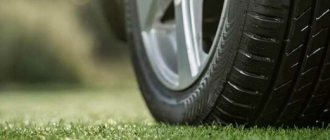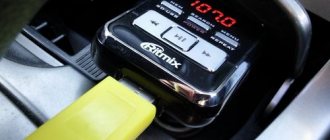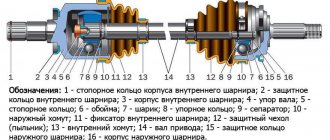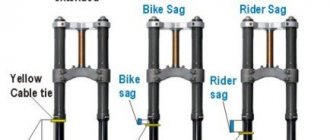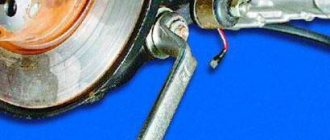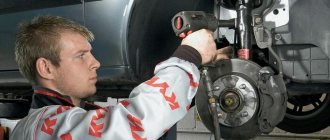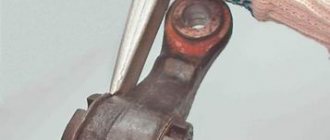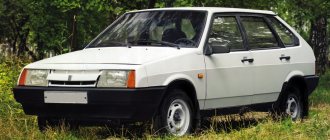The double-wishbone suspension with short upper and long lower arms ensures minimal lateral movement of the wheel (harmful to the lateral stability of the car and causing rapid tire wear), as well as minor angular movements during up and down travel. The wishbone configuration allows each wheel to independently absorb bumps and remain more upright on the road surface. And this means better grip.
MacPherson suspension, named after the engineer Earl MacPherson who developed it in 1960, is a wheel suspension consisting of a single link, an anti-roll bar and a unit of spring element and telescopic shock absorber, called a swaying plug, due to the fact that it It is fixed in the upper part to the body using an elastic hinge and can swing when the wheel moves up and down.
Kinematically, the scheme is less perfect than a suspension on two transverse or longitudinal arms: that with a large suspension stroke, the camber (the angle of inclination of the wheel to the vertical plane) will change, and the more, the greater the suspension stroke. But due to its manufacturability and low cost, this type of suspension has become very widespread in the modern automotive industry.
Multi-link suspension is somewhat reminiscent of double-wishbone suspension and has all its positive qualities.
These suspensions are more complex and more expensive, but provide a smoother ride and better vehicle handling. A large number of elements - silent blocks and ball joints - absorb shocks well when hitting obstacles sharply. All elements are mounted on the subframe through powerful silent blocks, which increases the noise insulation of the car from the wheels.
The use of multi-link independent suspension, which is mainly used on luxury cars, gives the suspension stable contact of the wheels with any surface on the road and precise control of the vehicle when changing direction.
The main advantages of a multi-link suspension:
-Independence of the wheels from each other, -Low unsprung weight, -Independent longitudinal and lateral adjustment, -Good understeer, -Good option for use in a 4x4 configuration. The main disadvantage of the modern scheme is complexity and, accordingly, price. Until recently, it was used only on expensive cars. Now it “holds” the rear wheels of even some golf cars.
Installation of pneumatic elements On all suspensions described above, the pneumatic element is installed according to a similar scheme. It fits onto the shock absorber rod through seals that ensure the tightness of the system. The place where the pneumatic element is attached to the rack body is also reliably sealed.
Rear dependent suspension
A typical representative of this design is a rear suspension with coil springs as elastic elements. As an example, we can cite the design of the rear suspensions of classic Zhiguli cars. In this case, the rear axle beam is “suspended” on two coil springs and additionally attached to the body using four trailing arms. In addition, to improve handling, reduce body roll in corners and improve ride smoothness, a transverse reaction bar is installed.
The main disadvantage of this type of suspension is the significant mass of the rear axle beam. This figure especially increases when the axle is driven: you have to “load” the beam with the weight of the main gear housing, gearbox, etc. And all this leads to an increase in the so-called unsprung masses, which causes the smoothness of the ride to deteriorate significantly and vibrations to appear.
Pendant type "De Dion"
In an effort to “lighten” the rear axle as much as possible, engineers at many automobile companies began to use the “De Dion” type suspension, named after its inventor, the Frenchman Albert De Dion. Its main difference is that the main gear housing is now separated from the axle beam and attached directly to the body. Now the torque is transmitted from the car engine to the drive wheels through axle shafts swinging on constant velocity joints. This type of suspension can be either dependent or independent. Something similar is used on off-road vehicles, in the design of the independent type front suspension.
But despite the improvement of the design, all dependent suspensions have one very significant drawback: the car exhibits unbalanced behavior when starting and braking. The car begins to “squat” during intense acceleration and “nod off” during braking. To eliminate this effect, additional guide elements began to be used.
Semi-independent rear suspension
Structurally, it is made in the form of two longitudinal arms, which are connected in the middle by a cross member. This type of suspension is used only in the rear, but on almost all front-wheel drive cars. Among the advantages of this design are ease of installation, compactness and low weight, as a result - a reduction in “unsprung masses”, and its most significant advantage is the most optimal kinematics of the wheel. There is only one drawback: such a suspension can only be used on a non-driving rear axle.
Installation of pneumatic elements If the spring and shock absorber are structurally installed separately from each other, the spring is simply replaced with a pneumatic element with spacers of the required thickness. Spacers are used to determine the minimum and maximum ground clearance of the vehicle. If the springs with shock absorbers are assembled into a single unit, like a front strut, then the pneumatic element is installed in the same way as on the front suspension - it is put on the shock absorber rod.
What is torsion bar suspension
In general terms, the torsion bar suspension diagram looks like this. One end of the rod is fixedly connected to the body, the other to the lever. The operating principle is based on the elasticity of the torsion bar. The car wheel, moving in a vertical plane, twists it, resulting in an elastic connection between the wheel and the car body. Unwinding to its normal state, the torsion bar returns the wheel to its original position. In the video you can see how this design works. » alt=»»> These elastic elements have two features:
- their rotation is possible only in the direction of twisting;
- with their help you can adjust the vehicle's ground clearance.
Trailing arm suspension
Its structure is as follows: one or two elastic elements are located across the body, and trailing arms are attached to them. This design was used, as a rule, for the rear suspension of small cars, but is not currently used.
It was first used on the Volkswagen Beetle; its front part had such a device. One of the cars with a rear trailing arm suspension was Renault 16. This car is interesting because it had a different wheelbase on the left and right. The reason is that the design of its rear axle used two torsion bars, located one behind the other.
Independent double wishbone suspension
In this case, the torsion bars are located along the body, one on each side, with one end they are attached to the frame, and the other to the transverse arm (usually to the lower one, although in some cars they can be attached to the upper one). The peculiarity of such a suspension is that the length of the torsion bars, and therefore their elastic properties, can be adjusted in a very wide range (the longer the length, the easier the elastic element is twisted, therefore, the softer the suspension). The front suspension of some off-road vehicles has such a device.
Talented McPherson
The scheme is named after the American engineer Earl Steely McPherson, who developed it in the second half of the 1940s. He set out to simplify the assembly technology of the front independent suspension. McPherson proposed attaching it only at two points on each side - in this case, the shock absorber acquired the role of a guiding element of the suspension. Each wheel had one lower transverse single arm. Instead of the traditional upper arm, a spring and a shock absorber coaxial with it were used, which in the upper part were connected to the body through a soft rubber cushion.
Pseudo-McPherson in the front suspension of the Mercedes-Benz C-Klasse: a single lower arm is divided into two independent ones. However, such a scheme is not considered a double-lever: there is no upper lever
From a production point of view, the design was undoubtedly advantageous, but when the wheel travels vertically, the lower arm describes an arc, and the point of contact of the tire with the road surface constantly moves left and right, and the camber angle of the wheels also changes noticeably.
This is what a modern McPherson looks like: a triangular lower boomerang arm is attached to the subframe, and the arm is connected to the shock absorber strut by a vertical stabilizer rod
Semi-independent suspension
This variety occupies a special place among suspensions in which the elastic element is a torsion bar. It is an intermediate link between independent and dependent suspensions, which is why it is called semi-independent. It has found wide application among many cars from “A” to “C” class. Its device looks like this. The trailing arms, located one on each side, are connected to each other by a torsion beam. One end of each of them is attached to the car body, and the other to the wheel hub.
Semi-independent rear
This type of suspension is based on a torsion beam, which has a U-shape. The trailing arms are located one on each side. The beam connects them together. The levers are attached with one side to the body, and the other to the wheel hub.
The beam resists bending well. At the same time, its shape does not prevent it from curling at all. The wheels may move slightly in the vertical plane relative to each other. The location of the torsion beam can be seen in the figure below.
Semi-independent suspension is used in budget cars with front-wheel drive. This is due to the simplicity of the design and low price of such machines.
Pros and cons of torsion bar suspension
Like any other design, torsion bar suspension has its pros and cons.
Its main advantages are as follows:
- compactness compared to spring suspension;
- simple device and high reliability;
- light weight;
- the ability to quickly change the vehicle's ground clearance without making changes to the design;
- good maintainability;
- long intervals between maintenance.
Disadvantages of torsion bar suspension:
- worse handling compared to multi-link suspension (cars tend to oversteer);
- complex technology for the production and processing of elastic elements;
- limited service life of needle bearings in the attachment points of the trailing arms to the torsion beam (about 60-70 thousand km); If the failed bearings are not replaced in a timely manner, the torsion beam will have to be repaired or replaced.
We have already talked about dependent and independent suspensions. But one more type of suspension remained behind the scenes - semi-independent. In the characteristics of a car, this type of suspension is often indicated as independent, but at first glance, the most common design looks exactly like a conventional dependent suspension beam. What's the secret?
How independent is independent suspension?
It would seem that since the suspension is independent, the movements of one wheel do not depend in any way on the other. This is more common in theory. In practice, completely independent suspensions are a rarity.
Almost always, the suspension design includes such a part as an anti-roll bar. Thanks to it, the vertical movements of one wheel are transmitted through an elastic torsion bar to the other. Such a “violation of independence” is necessary to improve the car’s handling, or more precisely, to reduce roll in corners. The solution is not the most elegant, and has a number of disadvantages, but it is inexpensive, because active suspensions are orders of magnitude more expensive. And so a fairly simple detail prevents the car from falling over in a turn.
Of course, the handling can be adjusted without this part, and even the smoothness of the ride will improve. There are many examples of this: Renault Logan, for example, after the first restyling, lost a stabilizer in the front, while classic Zhiguli cars never had one in the rear suspension. But most modern cars have it in both the front and rear suspensions.
Pictured: Renault Logan '2004–09
It’s not uncommon to have “active” stabilizers that can change the angular stiffness of the torsion bar or turn it off altogether. These exist, for example, on BMW cars or Nissan SUVs. This allows you to reduce the negative factors from using a stabilizer.
Pictured: Nissan Patrol '2014–present.
It turns out that the suspensions of the vast majority of cars are not completely independent; the movement of one wheel still causes the movement of the other. Albeit to a lesser extent than in the presence of a connection in the form of a common rigid axis, like a dependent suspension, when the movement of one wheel is always uniquely related to the movement of the second.
By the way, with continuous axles, a stabilizer bar is also used: cars with any suspension have rolls.
Semi-dependent: rare and most common
If a stabilizer is still needed, then maybe it can be made part of the supporting structure of the suspension? This is probably exactly what the engineers thought when they came up with the MacPherson front suspension for the Audi 100/A6 in the C4 body . Don’t be surprised, but her MacPherson is semi-independent, because instead of the front lower suspension arm, it uses a powerful anti-roll bar. Both wheels are connected by a single elastic part, which is part of the supporting structure. The eighties were generous with interesting technical solutions, so I wouldn’t be surprised if some other machines used a similar scheme, because the stabilizer torsion bar is very convenient to use as a lever. In terms of kinematics, the Audi suspension can be considered completely independent, with one significant “but”: the vertical movement of one of the wheels necessarily causes the movement of the second wheel by a significant amount, associated with a fairly high rigidity of the torsion bar.
A very common semi-independent suspension design with a torsion beam is also the result of the efforts of Volkswagen engineers. After all, it appeared on the VW Golf in 1974. The genius of the idea was that here the guide apparatus of both rear wheels was a single part, which was attached to the body at only two points. And the elastokinematics of movement of each of the wheels was almost similar to the kinematics of the suspension on the trailing arms. The H-shaped beam is attached to the body at two extreme points, and the wheel hubs are located at the lower ends of the letter. The most important part of the structure is the cross member, which connects the structure together and provides the necessary rigidity. If the beam is positioned close to the attachment points to the body (when the beam turns into the letter P), then the suspension according to the kinematic diagram will be completely similar to the design on trailing arms, and if moved closer to the attachment points of the wheels, it will be more similar to dependent suspensions. The central part of the beam in this design is necessarily flexible and can bend, providing the wheels with the ability to move independently. Such a suspension can be classified as dependent only structurally: the wheels are connected by a single part of the supporting structure. But in operation such a suspension is still similar to independent ones.
Would you like it softer?
Which pendant do you prefer? Soft or hard? Let’s answer very simply - the one that you like, but at the same time the one that the developers equipped this car model with. When purchasing a car, choose it on a “Hard - Soft” scale, rather than trying to improve the design after purchase. Shock absorbers from different manufacturers have different reputations on the market: some are stiffer, others are softer. But the manufacturer will never directly tell you about this. The box will indicate whether this shock absorber is applicable to your car or not.
Another way in which it is permissible to slightly change the stiffness of a car’s suspension is to install tires of a higher or lower profile from the range allowed by the manufacturer. Read about it here.
